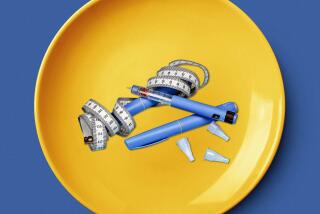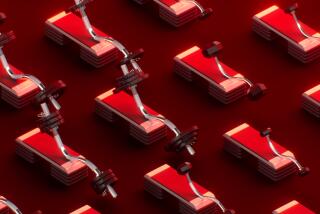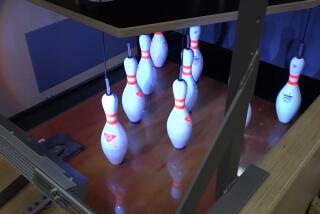Exercise Gadgets : Now, Silicon Muscles Into Health Game
Feeling fat? An ordinary bathroom scale can confirm your suspicions, but for a true measure, try the Skyndex. The $399 caliper gently pinches an inch or so of your midriff and then, thanks to its tiny built-in computer, calculates your overall body fat in just 30 seconds.
Want to jog off some of that fat? The microprocessor built in to the right heel of Puma’s new $200 running shoes will tell you exactly how many calories you burned on your latest run. In fact, just plug the sweaty shoe into your home computer and you will learn all about your trip: how far, how fast, the number of steps you took and how it compares to your earlier performances.
And if you want to know how fast your heart is beating during your workout, you can wear AMF’s $295 Quantum XL. Its pulse-sensing belt straps around your chest and transmits electrical signals to a radio you wear on your wrist, right where your watch would be. The radio flashes your heartbeat rate and sounds an alarm when you’re goofing off.
$100 Million in Sales Seen
As bizarre, or even comical, as it may seem, this is the state of the art these days in exercise equipment. And Americans, led by affluent, body-conscious young professionals, have turned these newfangled electronic exercise gadgets into a market that analysts expect will generate more than $100 million in annual sales within two years.
Last year, reports the National Sporting Goods Assn., retailers sold $1.2 billion worth of exercise equipment for the home, where a personal exercise spa has replaced the gourmet kitchen as the symbol of success. Although analysts estimate that less than 5% of the equipment contained silicon chips, manufacturers and retailers agree that high-technology workout gear is the most rapidly growing segment of this exploding market.
Jazz Up Machines
The shift from iron to silicon as a key element of the gym represents an increasing effort to make exercise more user-friendly. And manufacturers say that as the prices of electronic components continue to drop, they will be doing even more to jazz up their machines.
“We’re basically going to see exercise equipment combined with arcade games,” said Michael Hairston, a Long Beach physical therapist. “The bells and whistles don’t do anything for the actual training, but they do make exercise seem more fun than it really is.”
Already, one weightlifting machine has a Pac Man-like figure gobbling cheesecake in amounts equivalent to the calories burned by the user. And a soon-to-be-released rowing machine for health clubs allows high-scorers to leave their initials behind, just as kids do on the video games.
However, most equipment these days concentrates on detailing what has happened during the workout. Take, for instance, the ultra-sleek, ultra-slick Dynavit. This $3,500 stationary bike has electronic sensors that monitor pedal speed, work load, oxygen uptake, distance traveled and calories burned. Just punch a few buttons and whatever data you want is displayed on a panel attached to what passes for the bike’s handlebars.
“Just sweating or feeling tired isn’t good enough for a lot of people. With a computerized machine, you know exactly what you’re doing and if you’re doing what you should be,” said Patrick Netter, owner of a Hollywood exercise-gear shop and author of a high-tech fitness book.
The digital display panel on some of the machines available today represents the most eye-catching addition to the world of exercise since the shimmering leotard.
Tiny Flashing Lights
Bally’s Lifecycle, the $1,995 bike believed to have started the high-tech exercise craze, has a large panel that flashes tiny lights as the rider travels over a series of hills. Some riders claim to be so mesmerized by the lights that they forget about their aching legs.
Those not motivated by a steady stream of medical data or hypnotized by flashing lights should consider the Heart Mate, a $3,995 bicycle whose standard equipment includes a built-in AM/FM radio and black-and-white TV.
Not surprisingly, the electronic gadgets have attracted their fair share of detractors who wonder if consumers are just being enticed to spend ever larger sums for self-improvement equipment they don’t really need and that may end up in the closet of a spare room.
“It’s gimmickry, absolutely,” said Frances Caldwell, editor of Physician and Sportsmedicine magazine, with a sniff. “It’s probably all perfectly good stuff, but you don’t need all that to become physically fit.”
‘Want to Be Entertained’
Nevertheless, an increasing number of buyers are willing to spend at least three- and often four-figure amounts for machines that allow them to burn as many calories as they would mowing a lawn or vacuuming the house.
“Face it, people want to be entertained,” said Augie Nieto, executive vice president of Bally Fitness Products Corp., the Irvine subsidiary of Bally Corp., the game and theme park company that also has become the nation’s largest operator of health clubs. “And they’re willing to pay for something that’s going to offer them something more than sheer exercise.”
Last month, for example, Bally unveiled its new rowing machine, a $1,995 device that allows the user to “compete” in a two-boat race that is simulated in full color and sound on a 13-inch television monitor located right in the hull.
Nieto, ever quick to mention that Bally brought Pac Man to the world, says the company already has received orders for 2,200 rowing machines, despite advance notices that they won’t be ready for shipment for another four months.
Gave Away Machines
The market wasn’t always as enthusiastic. Four years ago, Nieto resorted to giving away his company’s Lifecycles to spur interest in the machines. For three months, Nieto traveled the country and personally delivered Lifecycles to the owners of the 25 largest health clubs in the nation.
The promotion, which cost $100,000, or one-third of the company’s sales that year, got results. “Once you’ve given someone a $3,000 product (the bike’s price at the time), they return your calls,” Nieto said.
Lifecycle’s sales grew, but so did their imitators and competition from other high-tech machines. Currently, there are dozens of electronic bikes, rowing machines, strength-trainers and treadmills on the market.
The competition, and ever-dropping cost of electronic circuitry, has brought prices down from the early days. However, an electronic bike still costs at least several hundred dollars more than one without a silicon brain. And, to the amazement of many, they sell.
“Three years ago, we didn’t think a consumer would spend $300 for a piece of exercise equipment,” said Jim Hoff, business manager of Diversified Products Inc.’s physical fitness division. “Now, that’s commonplace.”
Appearance Important
Some retailers suggest that price may be less important to their buyers than the performance and appearance of the gear.
Appearance may seem a strange concern, but since few buyers are able to devote an entire room to a gym, most equipment has to find a home around the rest of the furniture in the house. In fact, says Malcolm Mentor, a Dallas equipment retailer, “It has to look like part of the furniture” to appeal to most buyers.
AMF Inc. underscored the importance of design several months ago when it chose New York’s Whitney Museum as the location for the official unveiling of its new rowing machine and bicycle.
“We had won a number of design awards on the rowing machine,” explained Neil Talvar, AMF’s marketing director. “It’s state of the art and it fits at the Whitney as well as any place.”
Other manufacturers are looking for less obvious ways to fit their equipment into the house. Genesis Inc. of San Diego has designed a $4,000 armoire that unfolds into a treadmill, bicycle, rowing machine, weight bench, torso trestle, pull-up bar and leg lift.
For an encore, the company is working on a bike that folds into a coffee table.
More to Read
Inside the business of entertainment
The Wide Shot brings you news, analysis and insights on everything from streaming wars to production — and what it all means for the future.
You may occasionally receive promotional content from the Los Angeles Times.










